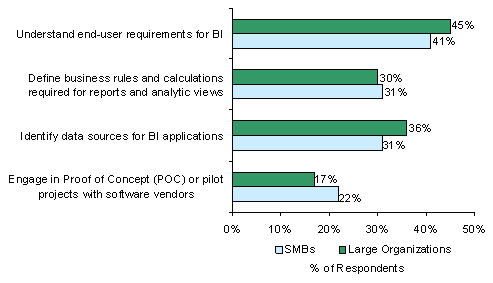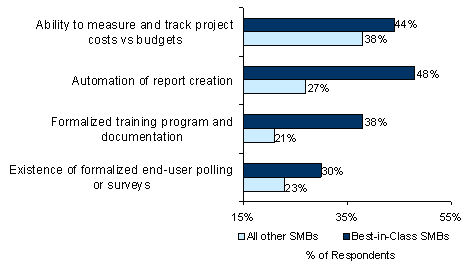Business Intelligence for Small to Medium size Businesses, Part 3: Driving Down TCO
In the final part of our three-part series, we investigate how organizations are managing the total cost of BI implementations.
- By Michael Lock, David Hatch
- November 12, 2008
by Michael Lock and David Hatch
As business intelligence (BI) solutions become more usable and useful to smaller organizations, the associated costs and the impact that these costs can have on the ultimate success or failure of BI projects has become a major concern. As a result, CIOs and business managers are investigating new licensing, implementation, delivery, and ongoing support options for BI solutions.
Many executives have become wary of hidden costs based on prior experiences with data warehousing and other enterprise application initiatives and are putting BI vendors to the test to disclose as much information as possible about the expected costs associated with their solutions. Although BI is becoming a higher priority in many organizations, adoption still remains a challenge, particularly in the SMB world (that of small and midsize businesses -- those with less than $500 million in annual revenue) as these companies frequently won’t have the internal IT resources to tackle the complexities involved with implementation and support.
The cost associated with this data complexity is also top of mind for SMBs. Aberdeen’s research shows that the top business pressure causing SMBs to stand up and take notice of the costs associated with BI is the need to improve integration of data from multiple business applications. Keeping a firm handle on BI project costs from start to finish has enabled substantive cost reductions for the top performing SMBs.
Strategies for Managing TCO
Another major challenge in managing BI costs is delivering analytical capabilities to more end users. This pressure is related to both the costs of supporting additional end users as well as user adoption of BI technologies. To address this challenge, both SMBs and large enterprises (defined as those with over $500 million in annual revenue) are implementing strategies that are focused on improvement of up-front analysis and planning for BI implementations (see Figure 1).

Figure 1 - Top Strategic Actions Focus on End-User Requirements
Source: Aberdeen Group, October 2008
Although all respondents agree that a three-fold focus -- on user requirements, data management, and business metric definitions -- is critical, Best-in-Class SMBs are 18% more likely to prioritize understanding end-user requirements for BI as the foremost strategic action they are taking. This highlights the importance of planning for BI implementations based on user requirements as a primary cost-management factor. Indeed, end-user respondents related this as a common thread during one-on-one conversations throughout the research process.
If end-user requirements are not well understood up-front, considerable time and effort will be wasted. The ability to understand end-user requirements is perhaps easier at smaller organizations, as well as the ability to identify data sources, as smaller companies tend to have fewer of them. Still, the tendency of BI to be traditionally implemented as an IT project factors in no matter what the company size. Organizations that take a user-needs led approach have faired better in terms of Aberdeen’s Best-in-Class analysis.
Essential Capabilities for BI Cost Management
Judicious selection of a BI solution is an important part of cost control, but it is far from the only aspect. Driving down some of the ongoing and hidden costs is heavily influenced by organizational maturity. After all, there is no one “cure-all” tool that can be used for lifetime cost management.
Aberdeen’s research shows that Best-in-Class SMBs are utilizing an efficient combination of internal capability, including process, organization, knowledge management, and performance measurement as a cornerstone of their cost-management strategy (see Figure 2).

Figure 2 - Best-in-Class Internal Capabilities
Source: Aberdeen Group, October 2008
SMB survey respondents unanimously indicate that the time, effort, and IT resources required to generate reports and deliver them to the right end users at the right time is a major cost factor, and research shows that Best-in-Class SMBs are far more likely than all others to have automation capabilities. Additionally, successful management of TCO for BI relies heavily on a company's understanding of the total range of cost factors involved and its ability to properly budget for project costs throughout the lifetime of BI ownership. Again, the research shows that Best-in-Class SMBs are more likely to possess this capability than all other SMBs.
Tangible, Achievable Cost Savings
Putting the time and effort into TCO management -- from measuring and tracking project cost to automating report delivery and providing employee training -- pays considerable dividends for top-performing SMB organizations. Aberdeen used three key performance criteria to distinguish the Best-in-Class SMBs from Industry Average and Laggard SMBs:
-
On-budget completion of BI projects: Fifth-nine percent of Best-in-Class SMBs achieved improvement of on-budget completion of BI projects in the past 12 months, versus 15% of Industry Average SMBs and 8% of Laggards
-
Cost-per-user of BI applications: Eighty-nine percent of Best-in-Class SMBs experienced a decrease in the cost-per-user of BI applications during the past 12 months, versus 8% of Industry Average SMBs and 1% of Laggards
-
Time-to-completion of BI projects: Thirty-six percent of Best-in-Class SMBs achieved average BI project time-to-completion of seven days or less during the past 12 months, versus 30% of Industry Average SMBs and 21% of Laggards
As SMB organizations attempt to deliver BI capabilities to more users, and as the volumes and complexity of data continue to increase, the cumulative effect on TCO is becoming a top management concern. Best-in-Class SMBs understand that the predominance of TCO drivers stems from on-going costs associated with supporting and growing BI implementations to meet expanding business and end-user requirements.
Best-in-Class performance is achieved through a complex combination of management strategies, capabilities, and technology enablement, and no one concept or direction can provide a "silver-bullet" for lowering total costs. To achieve Best-in-Class TCO management performance, companies must take a formalized approach to how they license and deploy BI technologies, as well as how they build a support structure for delivering BI to more end users, and address more business requirements across all areas of the company.
- - -
Michael Lock is a senior research associate in the technology markets group of Aberdeen Group. You can reach him at [email protected]. David Hatch is vice president and principal analyst at Aberdeen Group; you can contact him at [email protected].